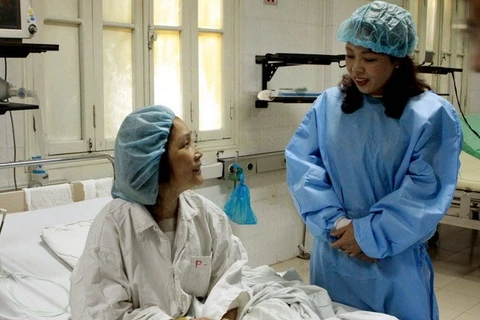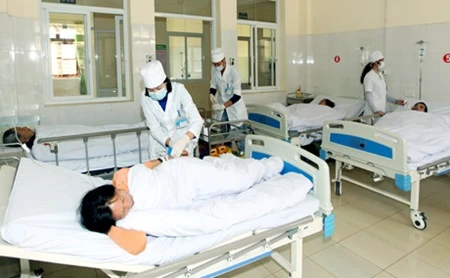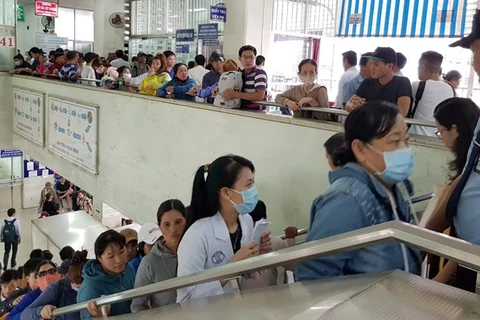Hanoi (VNA) – The private medical sector’s active engagement in health care has helped to raise the number of patient beds per 10,000 residents from 23.56 in 2011 to about 290,000 last year.
 The development of private heath care has contributed to easing patient overload at public hospitals (Photo: VietnamPlus)
The development of private heath care has contributed to easing patient overload at public hospitals (Photo: VietnamPlus) With advantages in patient beds and procedures, private hospitals are attracting more and more patients.
In major cities, the private medical sector plays an important role in easing patient overload at public hospitals.
Breakthroughs made by private health care
The private sector has been encouraged to invest in all medical activities, from drug and equipment production and supply, to training, consultation and health check-up. However, medical infrastructure has attracted most investments.
According to the Ministry of Health, Vietnam has 1,365 hospitals, excluding military ones run by the Ministry of National Defence, with a total of 253,447 hospitals and nearly 500,000 health workers.
After the nine-year implementation of the Law on Health Examination and Treatment, private health care has developed strongly in terms of both quality and quantity.
While there were only 102 private hospitals with 5,822 beds in 2011, the number of such facilities now stands at 248, along with 21,048 health clinics, with 15,475 beds.
Hanoi capital city has more than 3,600 private medical establishments and over 7,000 pharmaceutical facilities, according to the municipal Department of Health.
Meanwhile, in the northern mountainous province of Yen Bai, there are 201 private medical establishments, including one hospital, 171 medical clinics and 26 services.
Giving boost to private health care
Associate Professor Phan Le Thu Hang, deputy head of the finance-planning department under the Ministry of Health, said the Government has issued many policies to encourage the participation of different economic sectors in health care, especially the high-end segment, towards developing medical tourism.
Over the past years, major groups and businesses have injected investments in the construction of new hospitals equipped with thousands of patient beds and cutting-edge technologies.
The Government has also facilitated public-private partnership in this regard, Hang said, adding that the Ministry of Health will continue to work on solutions in order to promote the private sector’s participation in health care.
 Associate Professor Le Thi Thu Hang, deputy head of the finance-planning department under the Ministry of Health (Photo: VietnamPlus)
Associate Professor Le Thi Thu Hang, deputy head of the finance-planning department under the Ministry of Health (Photo: VietnamPlus) The official suggested improving the efficiency of State management in public health care and issuing incentives towards private health care, especially in disadvantaged areas, in line with approved plans and legal regulations.
The State needs to give strong support to non-profit private medical models in tax, capital and land, she said, stressing an equal environment for the public and private sector in support provision and technical transfer.
The Ministry of Health has issued a set of criteria to classify the quality of private hospitals and healthcare clinics across the country.
The move came after the Vietnam Social Security decided that in 2018, private hospitals and healthcare clinics that wanted to sign a contract with the agency to examine people with health insurance cards, would have to show a legal document proving their quality under the ministry’s standards.
Under the ministry’s decision No 6062/QĐ-BYT issued late December, the criteria to classify a private hospital includes the number of sickbeds, the structuring of doctors and nurses, the quality of staff - and the quality of infrastructure and facilities. Private hospitals would be classified at four levels. The highest rate is level one.
For example, a private hospital will be ranked level one if it has more than 400 sickbeds, the number of nurses is double the number of doctors, 60 percent of heads of hospital departments graduate with Ph.D degrees - and its facilities and infrastructure meet standards.
A private hospital will be ranked level two if it has 100-400 sickbeds, the number of nurses is not double the number of doctors and 20-60 percent of the heads of hospital departments have MA degrees.
A private hospital ranked level three would have to have 30-100 sickbeds, the number of nurses was not double the number of doctors and only 20 percent of heads of its departments have MA degrees.
Other private hospitals belong to level four.
In the meantime, all private healthcare clinics have been ranked level three./.
























